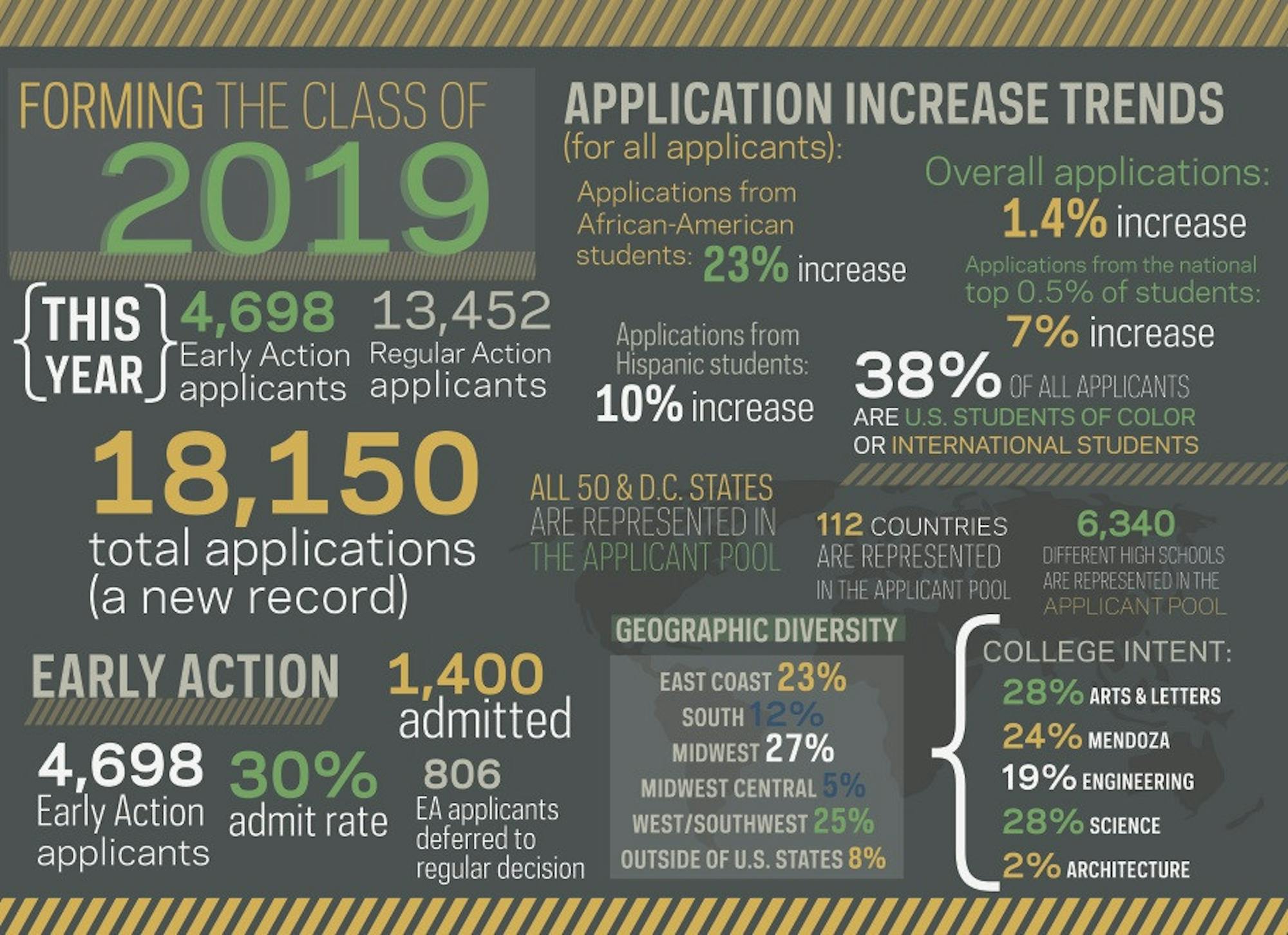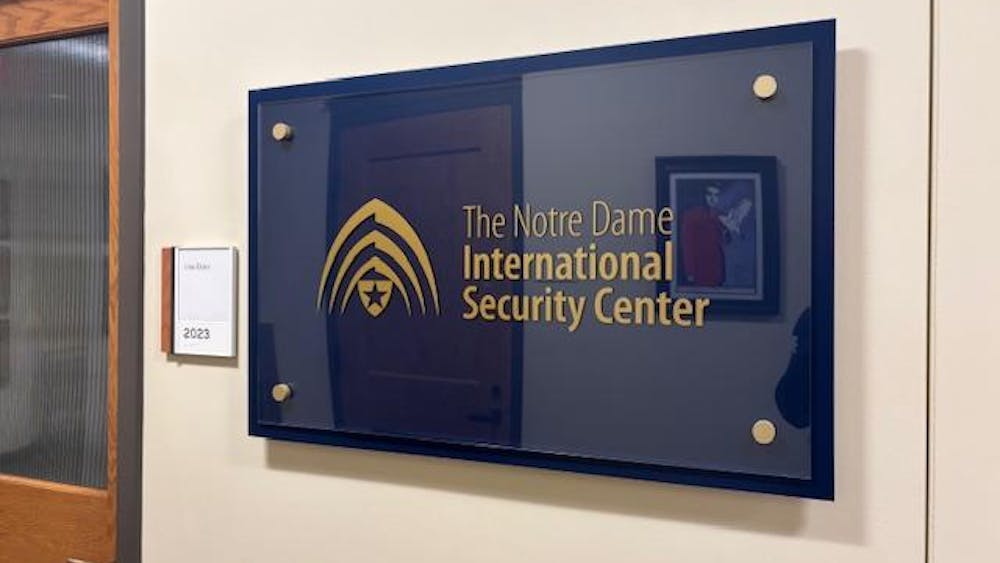
Keri O'Mara | The Observer
The total number of applicants to Notre Dame rose this year as early action numbers dipped, and the overall quality of the field improved, changes Associate Vice President for Undergraduate Enrollment Don Bishop attributed largely to the Office of Undergraduate Admissions’ switch from early action to restrictive early action.
“There’s one restriction: you cannot apply early here if you’re applying to a binding early decision program,” Bishop said. “…We believe as many as 200 to 300 students that were admitted last year in early action were obligated to turn down their offer of admission at Notre Dame to honor an early decision commitment elsewhere.”
Early action policies typically allow students to apply in mid-fall, before the regular deadline, and receive a decision between late December and mid-January. Regular applicants submit their materials in December and can receive decisions as late as April 1.
Director of Admissions Bob Mundy said the newly-implemented restriction offers a better chance of admission to students for whom the University is a top choice, ruling out any candidates who would already be committed to attending another college or university by the time they hear a decision from Notre Dame.
“The two biggies [in early application policies] are early action and early decision, and obviously, if a student is applying early decision someplace else and is admitted, they’re bound there,” Mundy said. “So we merely asked them to wait for that to run its course and then apply to us in regular action. We expected that our [early] applicant pool would be smaller because of that … [and] that is what happened.”
Bishop said an increase in regular applications offset the decline in early applications, leading to a larger applicant pool overall. He estimated Admissions received 18,150 total applications, as compared to 17,901 last year.
“My guess is we probably dropped out of the system about 800 to 1,000 apps [in the early action period], and then we replaced them with around 1,200 other apps [in the regular cycle], so our net gain was favorable,” Bishop said. “We also noticed that the very top of the pool did not decline. Seven percent increase in that top half of [the top] one percent in the nation, which means usually 1550 or higher on the SAT and 35 [or] 36 on the ACT, so the very top of the pool’s gotten bigger and better.”
Bishop said the Admissions staff decided to implement the early application restriction after examining various policies at other colleges and universities and determining which would best preserve Notre Dame’s mission and the applicants’ freedom while still valuing the application readers’ time and energy. The staff examined three main options, including early decision — which Bishop said about half of the top 15 schools in the nation use.
“We continue to believe that’s not the right choice for us, given our philosophy of trying to provide students with the most choice,” Bishop said.
Top-tier universities often use early decision to improve their yield rate, which measures how many admitted students actually enroll in the university, Bishop said. Because all accepted students are bound to attend, the yield rate for early decision is 100 percent, a figure that impacts overall yield rate and helps with recruitment and fundraising.
“Our yield rate would be even higher if we had early decision, but we’ve decided that’s not in the best interest of the students,” Bishop said. “We continue to try to make admissions policies that benefit the students more than the private agenda of a university. We view early action as a friendlier opportunity to applicants, and Notre Dame’s philosophy just as an institution is more aligned with early action.”
Bishop said Notre Dame’s current yield rate reflects a high level of commitment from the applicants considering the University as a top priority.
“One of the reasons why we don’t do early decision is we already enjoy a very high conversion rate — we’re in the top eight in the country, and if you look at the top eight, probably half of them have single choice and half of them have early decision,” Bishop said. “We’re probably the only one of the eight that doesn’t have one or the other that improves yield rate.
“We’re lucky that students really view Notre Dame as not just a generic top-10 university, but they view it as their No. 1 choice,” he said. “Once they decide that their value system aligns with Notre Dame, we get them. Often the students we lose get in to other top 15 schools, but they ultimately don’t have the same value system. Something else is valued more than our value system here, and therefore that causes them to choose another institution, and we think that’s perfectly fine.”
After deciding against early decision, Bishop said the Admissions office evaluated alternative early action plans, including single-choice early action, which is not binding but prohibits applicants from applying early to any other institutions. Most of the top five universities, including Harvard, use this method, Bishop said.
“Our view was that there were a couple other schools that had this restrictive early action, not single-choice,” he said. “And we thought that was the best choice for us, and the reason why we wanted to make a choice and not just leave it open ended is that it was a one-sided relationship. The applicant had complete freedom to do whatever they wanted, and expected from us a certain loyalty of letting them know early and committing to them early.
“I feel it should be a two-sided relationship, in that if a student truly has a preference for another university, I don’t think it’s fair to the rest of our applicants — who are extraordinary applicants — for that spot to be taken by a student that’s not committed at this point, that has by definition committed themselves to another institution’s identity.
“If a student prefers to commit their allegiance to another school, they should be allowed to do that without taking a spot away from a student at Notre Dame until they know one way or the other,” Bishop said.
Students who apply elsewhere through early decision or single-choice early action will still have the option of applying to Notre Dame through regular action, Bishop said.
“It is a minimal condition, just one single restriction,” he said. “If you’re ready to prefer somewhere else, go after that first. If you don’t get that, feel free to apply regular.
And the good news is, we don’t over-admit early, so you have the same chance for selection in regular as if you’d applied early. There’s no penalty for applying regular.”
Mundy said the restriction helps identify students who are serious about attending the University and prioritize it before single-choice and early-decision schools.
“We’re trying to identify those students who are most serious about Notre Dame, without requiring them to make the ultimate serious choice,” he said.
Bishop said the Admissions team uses numbers and test scores less in the overall process and instead places extra emphasis on the applicant’s aspirations and values.
“The bottom line is … are they going to take the best advantage of what Notre Dame is trying to provide them, or not?” he said. “I think we are recognizing more now what are the elements that make a unique and successful Notre Dame student and alum.”









